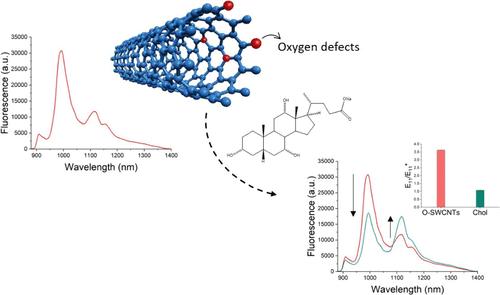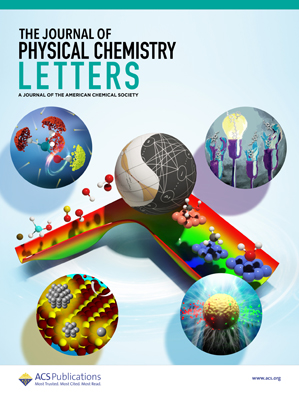Ratiometric Normalization of Near-Infrared Fluorescence in Defect-Engineered Single-Walled Carbon Nanotubes for Cholesterol Detection
IF 4.8
2区 化学
Q2 CHEMISTRY, PHYSICAL
引用次数: 0
Abstract
Ratiometric probing of analytes presents a substantial advancement in molecular recognition, offering self-calibrating signals that enhance the measurement accuracy and reliability. We present a dual-emitting probe based on (6,5) chirality-enriched single-walled carbon nanotubes (SWCNTs) with oxygen defects for cholesterol (Chol) detection using ratiometric fluorescence readouts. The interaction with Chol induced significant intensity variations in the E11 and E11* emission peaks of oxygen defect-induced SWCNTs, giving rise to ratiometric fluorescence changes. The sensitivity of these probes toward Chol in water and serum was 0.28 ± 0.01 and 0.72 ± 0.05 μM, respectively, which is comparable to that of common gold standards for cholesterol detection used in clinical samples. By utilizing ratiometric readouts, our approach enhanced selectivity over numerous competing analytes, including amino acids, sugars, cations, anions, proteins, steroid hormones, surfactants, and phospholipids. Mechanistic investigations revealed that Chol detection by defect-integrated SWCNTs was facilitated by Chol incorporation within micelles formed by sodium cholate, the surfactant dispersant used for the SWCNT suspension. Oxygen defects played a crucial role by directly interacting with Chol. This strategy employing defect-integrated dual-peak NIR-emitting SWCNTs as sensors for Chol in aqueous and serum environments not only enables background-free detection of biologically relevant analytes but also advances biosensing using SWCNTs through tailored surface functionalization and advanced read-out concepts.

用于胆固醇检测的缺陷工程单壁碳纳米管近红外荧光比率归一化技术
分析物的比率探针是分子识别领域的一大进步,它提供的自校准信号提高了测量的准确性和可靠性。我们介绍了一种基于具有氧缺陷的(6,5)手性富集单壁碳纳米管(SWCNTs)的双发射探针,利用比率荧光读数检测胆固醇(Chol)。与胆固醇的相互作用会导致氧缺陷诱导的单壁碳纳米管的 E11 和 E11* 发射峰出现明显的强度变化,从而引起比率荧光变化。这些探针对水中和血清中胆固醇的灵敏度分别为 0.28 ± 0.01 和 0.72 ± 0.05 μM,与临床样本中常用的胆固醇检测金标准相当。通过利用比率读数,我们的方法提高了对氨基酸、糖、阳离子、阴离子、蛋白质、类固醇激素、表面活性剂和磷脂等众多竞争分析物的选择性。机理研究表明,通过缺陷集成的 SWCNTs 对胆醇的检测是通过胆醇在胆酸钠(用于 SWCNT 悬浮液的表面活性剂分散剂)形成的胶束中的结合来实现的。氧缺陷通过与 Chol 直接相互作用发挥了关键作用。这种采用缺陷集成双峰近红外发光 SWCNT 作为水和血清环境中胆醇传感器的策略不仅能实现对生物相关分析物的无背景检测,还能通过定制的表面功能化和先进的读出概念推进使用 SWCNT 的生物传感技术。
本文章由计算机程序翻译,如有差异,请以英文原文为准。
求助全文
约1分钟内获得全文
求助全文
来源期刊

The Journal of Physical Chemistry Letters
CHEMISTRY, PHYSICAL-NANOSCIENCE & NANOTECHNOLOGY
CiteScore
9.60
自引率
7.00%
发文量
1519
审稿时长
1.6 months
期刊介绍:
The Journal of Physical Chemistry (JPC) Letters is devoted to reporting new and original experimental and theoretical basic research of interest to physical chemists, biophysical chemists, chemical physicists, physicists, material scientists, and engineers. An important criterion for acceptance is that the paper reports a significant scientific advance and/or physical insight such that rapid publication is essential. Two issues of JPC Letters are published each month.
 求助内容:
求助内容: 应助结果提醒方式:
应助结果提醒方式:


